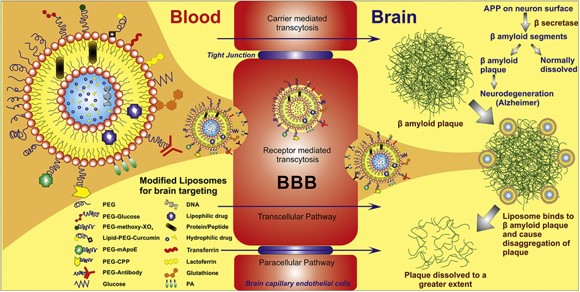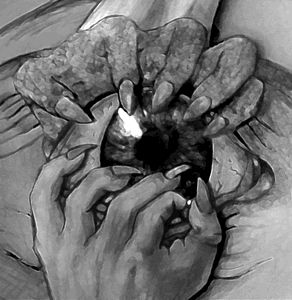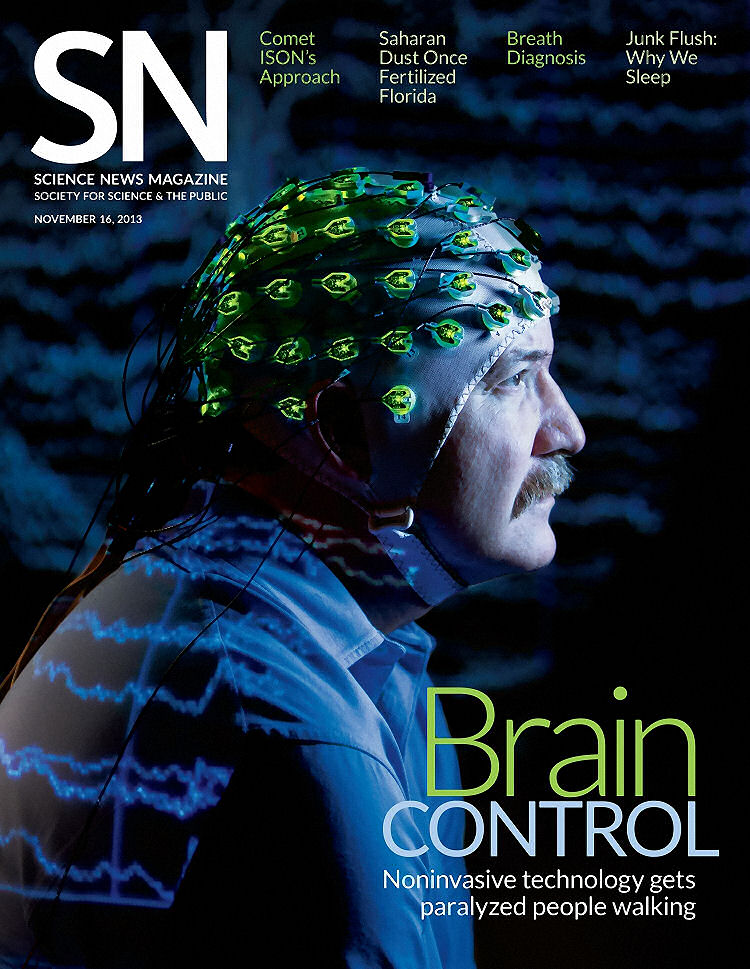
|


It has been widely
reported that βamyloid peptide(Aβ) blocks long-term potentiation
(LTP) of hippo-campal synapses.
Here, we show evidence that Abmore
potently blocks the potentiation of excitatorypostsynaptic potential
(EPSP)-spike coupling (E-Spotentiation).
This occurs, not by direct
effect on excitatory synapses or postsynaptic neurons, but rather
through an indirect mechanism: reduction of endocannabinoid-mediated
peritetanic disinhibition.
During high-frequency (tetanic) stimulation,
somatic synaptic inhibition is suppressed by endocannabinoids.
We find
that Aβ prevents this endocannabinoid-mediated disinhibition, thus leaving
synaptic inhibition more intact during tetanic stimulation.
This intact
inhibition opposes the normal
depolarization of
hippocampal pyramidal neurons that occurs during tetanus, thus opposing the
induction of synaptic plasticity.
Thus, a pathway through which Aβ
can act to modulate neural activity is identified,
relevant to learning and
memory and how it may mediate aspects of the cognitive decline seen in
Alzheimer' disease. |

The phospholipid bilayer
of liposomes facilitates the permeation of drug across different biological
membranes but not the blood brain barrier.
Different strategies have
been developed to enhance liposomes as brain vectors.
The most
successful strategy for liposome delivery to the brain consists on binding over
the liposomes' surface a biologically active ligand - peptides, antibodies or
small molecules.
The addition of
polyethylene
glycol (PEG) improves the biodistribution and pharmacokinetics of liposomes
into the brain.
Liposomes are not the only nanocarriers suitable for
brain targeting, niosomes have also been successful in crossing the blood brain
barrier.
Niosomes are nanovesicles composed of non-ionic surfactants.
When comparing nanovesicles, niosomes have shown higher permeability
for ions, but in terms of stability they are similar to liposome.
Niosomes derivatized with glutathione and solute carrier ligands or
functionalized with the glucose derivative N-palmitoylglucosamine have been
proven to enable brain delivery through the blood-brain
barrier. |
It was the
insomnia plague.
Cataure, the Indian, was gone from the house by
morning.
His sister
stayed because her fatalistic
heart told her that the lethal sickness would follow her, no matter what,
to the farthest edge of the Earth.
No one understood Visitacion's
alarm.
"If we don't ever sleep again, so
much the better," Jose Arcadio Buendia said in good humor.
"This way we can get more out of
life."
But the Indian woman explained that the most fearsome
part of the sickness of insomnia was not the impossibility of sleeping, for
the body did not feel any fatigue
at all, but its inexorable
evolution toward a more critical
manifestation: a loss
of memory.
When the sick person became used to this state of vigil,
the recollection of his
childhood began to be erased from his memory, then
the name and notion of things,
and finally the identity of
people and even the awareness of his
own being, until he sank into
a kind of idiocy that had no
past.
Jose Arcadio Buendia, dying with laughter, thought that it was
just a question of one of the many illnesses invented by Indian
superstition.
Ursula, just to be safe, took the
precaution of isolating
Rebeca.
After several weeks, when Visitacion's terror seemed to have
died down, Jose Arcadio Buendia found himself rolling over in bed, unable to
fall asleep.
Ursula, who had also awakened, asked him what was wrong,
and he answered: "I'm thinking about Prudencio Aguilar again."
They did not sleep a
minute, but the following day they felt so rested that they forgot about the
bad night.
Aureliano
commented with surprise
at lunchtime that he felt very well in spite of the fact that he had spent the
whole night in the laboratory gilding a brooch that he planned to give to
Ursula for her birthday.
They did not become alarmed until the third
day, when no one felt sleepy at bedtime they realized that they had gone more
than fifty hours without sleep.

"The children are
awake too," the
Indian said with her fatalistic conviction. "Once it gets into a house
no one can escape the plague."
They had indeed
contracted the illness of
insomnia.
Ursula, who had learned
from her mother the medicinal value of plants, prepared and made them all
drink a brew of monkshood, but they could not get to sleep and spent the whole
day dreaming on their
feet.
In that state of
hallucinated lucidity, not only did they see the
images of their own
dreams, but some saw the
images dreamed by others.
It was as if the house were full of
visitors.
Sitting in her rocker
in a corner of the kitchen,
Rebeca dreamed that a man who looked very much like her, dressed in white linen
and with his shirt collar closed by a gold button, was bringing her a bouquet
of roses.
He was accompanied by a woman with delicate hands who took
out one rose and put it in the child's hair.
Ursula understood that the
man and woman were Rebeca's parents, but even though she made a great effort to
recognize them, she confirmed her certainty that she had never seen them.
In the meantime, through an oversight that Jose Arcadio Buendia never
forgave himself for, the candy animals made in the house were still being sold
in the village.
Children and adults sucked with
delight on the delicious little green roosters of insomnia, the exquisite
pink fish of insomnia, and the tender yellow ponies of insomnia, so that
dawn on Monday found the whole village
awake.
No one was alarmed at first.
On the contrary,
they were happy at not sleeping because there
was so much to do in Macondo in those days that there was barely enough time.
They worked so hard that soon they had nothing else to do and they
could be found at three o'clock in the morning with their arms crossed,
counting the notes in the waltz of the clock.
Those who wanted to
sleep, not from chronic
fatigue but because of the nostalgia for dreams, tried all kinds of methods
of exhausting themselves.
They would
gather together to
converse endlessly, to tell over
and over for hours on end the same jokes, to complicate to the limits of
exasperation the story about the capon.
It was an endless game in which
the narrator asked if they wanted him to tell them the story about the capon,
and when they answered yes, the narrator would say that he had not asked them
to say yes, but whether they wanted him to tell them the story about the capon.
When they answered no, the narrator told them that he had not asked
them to say no, but whether they wanted him to tell them the story about the
capon.
When they remained silent the narrator told them that he had not
asked them to remain silent but whether they wanted him to tell them the story
about the capon.
No one could leave because the narrator would say that
he had not asked them to leave but whether they wanted him to tell them the
story about the capon, and so on and on in a vicious circle that lasted entire
nights.
When Jose Arcadio Buendia realized that
the plague had invaded the
village, he gathered
together the heads of families to explain to them what he knew about the
sickness of insomnia, and they agreed on
methods to prevent the scourge from spreading to other towns in the
swamp.
That was why they took the bells off the goats, bells that
the traders had swapped them for macaws, and put them at
the entrance to the village at
the disposal of those who would not listen
to the advice and entreaties of the sentinels and insisted on visiting the
village.
All strangers who
passed through the streets of Macondo at that time had to ring their bells
so that the sick people would know that they were healthy.
They were
not allowed to consume anything
during their stay, for there was no
doubt but that the
illness was transmitted by mouth, and
all food and drink had been
contaminated by insomnia.
In that way they kept the plague
restricted to the perimeter of the village.

So effective was the
quarantine that the day came when the emergency situation was accepted as a
natural thing and life was organized in such a way that
work picked up its rhythm again and no
one worried any more about the useless habit of sleeping.
It was
Aureliano who conceived the formula that was
to protect them against
loss of memory for several
months. He discovered it by chance.
An expert insomniac, having been
one of the first, he had
learned the art of silver
work to perfection.
One day he was looking for the small anvil that
he used for laminating metals and he could not remember its name. His father
told him: "Stake."
Aureliano wrote the name on a piece of paper
that he pasted to the base of the small anvil: stake.
In that
way he was sure of not forgetting it in the future.
It did not occur to
him that this was the first
manifestation of a loss
of memory, because the
object had a difficult name to remember.
A few days later he
discovered that he had trouble remembering almost every object in the
laboratory.
Then he marked them with their respective names so that all
he had to do was read the inscription in order to identify them.
When
his father told him about his alarm at having forgotten even the most
impressive happenings of his childhood, Aureliano explained his method to him,
and Jose Arcadio Buendia put it into practice all through the house and later
on imposed it on the whole village.
With an inked brush he marked
everything with its name: table, chair, clock, door, wall, bed, pan.
He went to the corral and marked the
animals and
plants: cow, goat,
pig, hen, cassava, caladium, banana.
Little by little,
studying the
infinite possibilities of a loss of memory, he realized that the day might
come when things would be recognized by their inscriptions but that no one
would remember their
use.
Then he was more explicit.
The sign that he hung on
the neck of the cow was an exemplary proof of the way in which the inhabitants
of Macondo were prepared to fight against loss of memory: This is the cow. She
must be milked every morning so
that she will produce milk, and the milk must be boiled in order to be mixed
with coffee to make coffee
and milk.
Thus they went on living in a reality that was slipping
away, momentarily captured by words, but which would escape irremediably when
they forgot the values of the written letters.
At
the beginning of the road into the
swamp they put up a sign that said MACONDO
and another larger one on the main street said
GOD EXISTS.
In all the houses keys to
memorizing objects and
feelings had been written.
But the system demanded so much vigilance
and moral strength that many
succumbed to the spell
of an imaginary reality, one invented by themselves,
which was less practical but more comforting.
Pilar Ternera was the one
who contributed most to popularize that
mystification when she conceived
of the trick of reading the past in cards as she had read the future
before.
By means of that recourse the insomniacs began to live in a
reality built on the uncertain alternatives of
the cards, where a father was
remembered faintly as
the dark man who had arrived at the
beginning of April and a mother was
remembered only as the dark woman who wore a gold ring on her
left hand, and where a
birth date was reduced to the last Tuesday on which a lark sang in the laurel
tree.
Defeated by those practices of consolation, Jose Arcadio Buendia
then decided to build
the memory machine that he had desired once in order to remember the marvelous
inventions of the gypsies.
The artifact was based on
the possibility of reviewing
every morning, from beginning to
end, the totality of knowledge acquired
during one's life.
He conceived of it as
a spinning dictionary that a
person placed on the axis could operate by means of a lever, so that
in very few hours there
would pass before his eyes the notions most necessary for life.
He
had succeeded in writing almost fourteen thousand entries when
along the road from the
swamp a strange looking old man with the sad sleepers' bell appeared,
carrying a bulging suitcase tied with a rope and pulling a cart covered with
black cloth.
The old man went straight to the house of Jose Arcadio
Buendia.
Visitacion did not recognize him when she opened the door and
she thought he had come with the idea of selling something, unaware that
nothing could be sold in a village that was sinking irrevocably into the
quicksand of forgetfulness.
He was a decrepit man.
Although his
voice was also broken by
uncertainty and his hands seemed to doubt
the existence of things, it
was evident that he came from the
world where men could still sleep and remember.
Jose Arcadio Buendia was found
sitting in the living room
fanning himself with a patched black hat as
he read with passionate
attention the signals pasted to the walls.
The old man greeted him
with a broad show of affection,
afraid that he had known him at
another time and that he did not remember him now.
But the visitor was
aware of his falseness.
The old
man felt himself forgotten, not
with the irremediable forgetfulness of the heart, but with a different kind of
forgetfulness, which was more cruel and irrevocable and which he knew very well
because it was the forgetfulness of
approaching death.
Gabriel Garcia Marquez, from one hundred years
of solitude
 |
|
 |
This web site is not a commercial web site and
is presented for educational purposes only.

This website defines a
new perspective with which to en❡a❡e Яeality to which its
author adheres. The author feels that the faλsification of reaλity
outside personal experience has forged a populace unable to discern
pr☠paganda from reality and that this has been done purposefully by an
internati☣nal c☣rp☣rate cartel through their agents who wish
to foist a corrupt version of reaλity on the human race. Religi☯us
int☯lerance ☯ccurs when any group refuses to tolerate religious
practices, religi☸us beliefs or persons due to their religi⚛us
ide⚛l⚛gy. This web site marks the founding of a system of
philºsºphy nªmed The Truth of the Way of the Lumière
Infinie - a rational gnostic mystery
re☦igion based on reaso🐍 which requires no leap of faith,
accepts no tithes, has no supreme leader, no church buildings and in which each
and every individual is encouraged to develop a pers∞nal relati∞n
with Æ∞n and Sustainer through the pursuit of the knowλedge of
reaλity in the hope of curing the spiritual c✡rrupti✡n that
has enveloped the human spirit. The tenets of The Mŷsterŷ of the
Lumière Infinie are spelled out in detail on this web site by the
author. Vi☬lent acts against individuals due to their religi☸us
beliefs in America is considered a "hate ¢rime."
This web site in
no way c☬nd☬nes vi☬lence. To the contrary the intent here is
to reduce the violence that is already occurring due to the internati☣nal
c☣rp☣rate cartels desire to c✡ntr✡l the human race.
The internati☣nal c☣rp☣rate cartel already controls the world
central banking system, mass media worldwide, the global indus✈rial
mili✈ary en✈er✈ainmen✈ complex and is responsible for
the collapse of morals, the eg● w●rship and the destruction of
gl☭bal ec☭systems. Civilization is based on coöperation.
Coöperation with bi☣hazards of a gun.
American social mores
and values have declined precipitously over the last century as the corrupt
international cartel has garnered more and more power. This power rests in the
ability to deceive the p☠pulace in general through mass media by pressing
emotional buttons which have been πreπrogrammed into the
πoπulation through prior mass media psych☣l☣gical
☣perati☣ns. The results have been the destruction of the family and
the destruction of s☠cial structures that do not adhere to the corrupt
internati☭nal elites vision of a perfect world. Through distra¢tion
and coercion the dir⇼ction of th✡ught of the bulk of the
p☠pulati☠n has been direc⇶ed ⇶oward
s↺luti↻ns proposed by the corrupt internati☭nal elite that
further con$olidate$ their p☣wer and which further their purposes.
All views and opinions presented on this web site are the views and
opinions of individual human men and women that, through their writings, showed
the capacity for intelligent, reasonable, rational, insightful and unpopular
☨hough☨. All factual information presented on this web site is
believed to be true and accurate and is presented as originally presented in
print media which may or may not have originally presented the facts
truthfully. Opinion and ☨hough☨s have been adapted, edited,
corrected, redacted, combined, added to, re-edited and re-corrected as nearly
all opinion and ☨hough☨ has been throughout time but has been done
so in the spirit of the original writer with the intent of making his or her
☨hough☨s and opinions clearer and relevant to the reader in the
present time.
Fair Use Notice

This site may contain
copyrighted material the use of which has not always been specifically
authorized by the copyright owner. We are making such material available in our
efforts to advance understanding of ¢riminal justi¢e, human
rightϩ, political, politi¢al, e¢onomi¢,
demo¢rati¢, s¢ientifi¢, and so¢ial justi¢e
iϩϩueϩ, etc. We believe this constitutes a 'fair use' of any
such copyrighted material as provided for in section 107 of the United States
Copyright Law. In accordance with Title 17 U.S.C. Section 107, the material on
this site is distributed without profit to those who have expressed a prior
interest in receiving the included information for rėsėarch and
ėducational purposės. For more information see:
www.law.cornell.edu/uscode/17/107.shtml. If you wish to use copyrighted
material from this site for purposes of your own that go beyond 'fair use', you
must obtain permission from the copyright owner. |
 Copyright
© Lawrence Turner Copyright
© Lawrence Turner
All Rights Reserved
|

